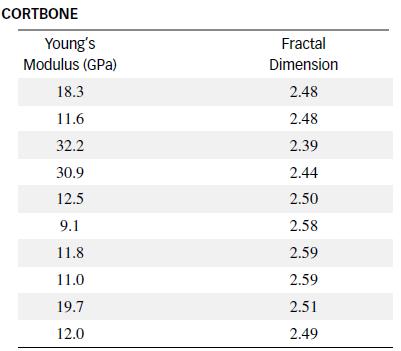Refer to the Medical Engineering & Physics (May 2013) study involving the use of fractal geometry to
Question:
Refer to the Medical Engineering & Physics (May 2013) study involving the use of fractal geometry to characterize human cortical bone, Exercise 10.13. Experimental data on fractal dimension, x (a measure of the variation in the volume of cortical bone tissue) and Young’s Modulus, y (a measure of bone tissue’s stiffness) for each in a sample of 10 human ribs are reproduced in the table below. Consider the linear model, E(y) = βo + β1x.

a. Construct Y and X matrices for the data.
b. Find X'X and X'Y.
c. Find the least squares estimates β̂ = (X'X)-1 X'Y.
d. Find SSE and s2.
e. Conduct the test, Ho: β1 = 0 vs. Ha: β1 ≠ 0 at α = .01.
f. Find and interpret R2.
g. Find and interpret a 95% prediction interval for y when x = 2.50.
Data from Exercise 10.13
In Medical Engineering & Physics (May 2013), researchers used fractal geometry to characterize human cortical bone. A measure of the variation in the volume of cortical bone tissue—called fractal dimension—was determined for each in a sample of 10 human ribs. The researchers used fractal dimension scores to predict the bone tissue’s stiffness index, called Young’s Modulus (measured in gigapascals). The experimental data are shown below. Consider the linear model, E(y) = βo + β1x where y = Young’s Modulus and x = fractal dimension score.
Step by Step Answer:

Statistics For Engineering And The Sciences
ISBN: 9781498728850
6th Edition
Authors: William M. Mendenhall, Terry L. Sincich





